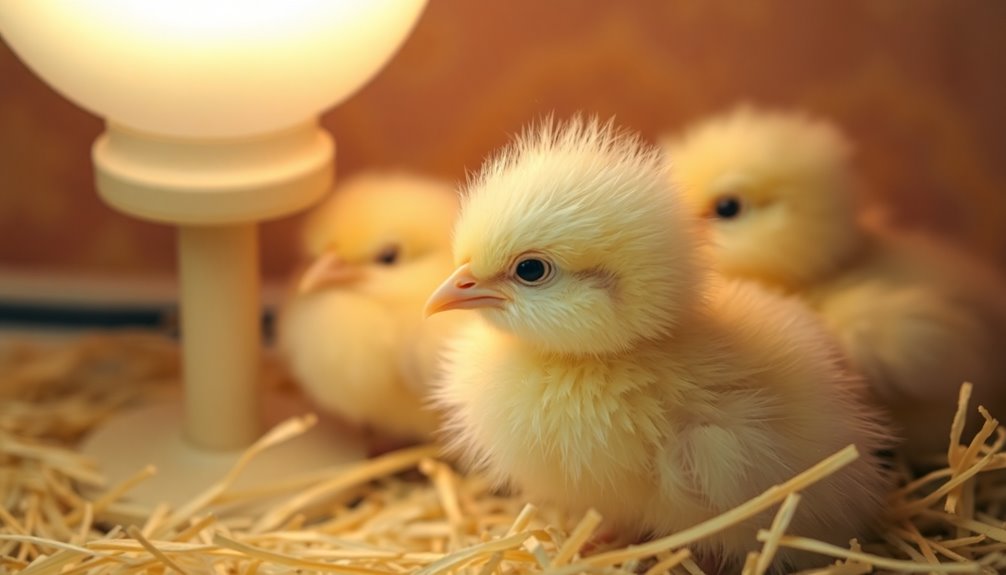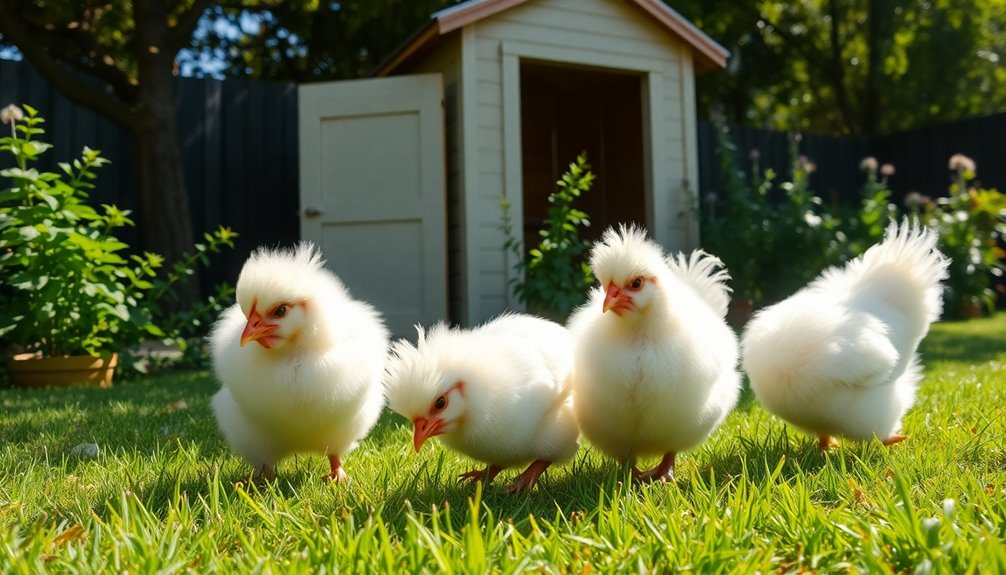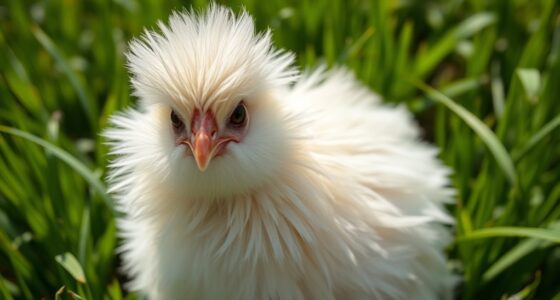You can tell your baby chicks are cold if they huddle together, pile near a heat source, or chirp excessively. The brooder temperature should start at 90°F to 95°F and gradually decrease. Make sure they have clean water and quality starter feed to support their health. Use proper bedding and insulation to avoid drafts, while monitoring their behavior for signs of discomfort. Huddling or wing spreading indicates they need adjustments in temperature. For more tips on keeping your chicks warm and healthy, there's more helpful info waiting for you to discover.
Key Takeaways
- Look for huddling behavior; chicks pile together when they need warmth and feel cold.
- Maintain brooder temperature between 90°F to 95°F initially, lowering it gradually each week.
- Monitor for excessive chirping or shivering, which indicates distress due to inadequate heat.
- Provide high-quality starter feed with 20% protein to support growth and heat generation.
- Ensure proper ventilation to prevent overheating and ammonia buildup while insulating the brooder for warmth.
Recognizing Cold Stress in Chicks
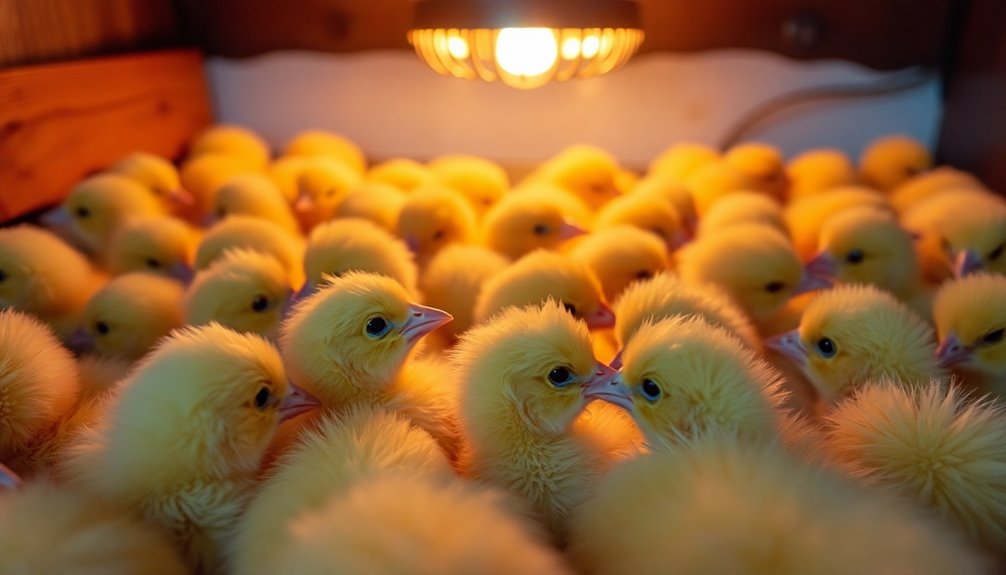
Recognizing cold stress in chicks is vital for their well-being. When you notice your chicks huddling together, it's a clear sign they're seeking warmth due to low temperatures.
In a proper brooder setup, you should monitor the temperature closely, ensuring it stays around 70°F or higher. If you see chicks piling up near a heat source, they're likely cold and need consistent heat.
Distressed chicks may chirp excessively or shiver, indicating they require immediate attention. Make sure your chicks have access to clean water, which is essential for their health.
Essential Heating Methods
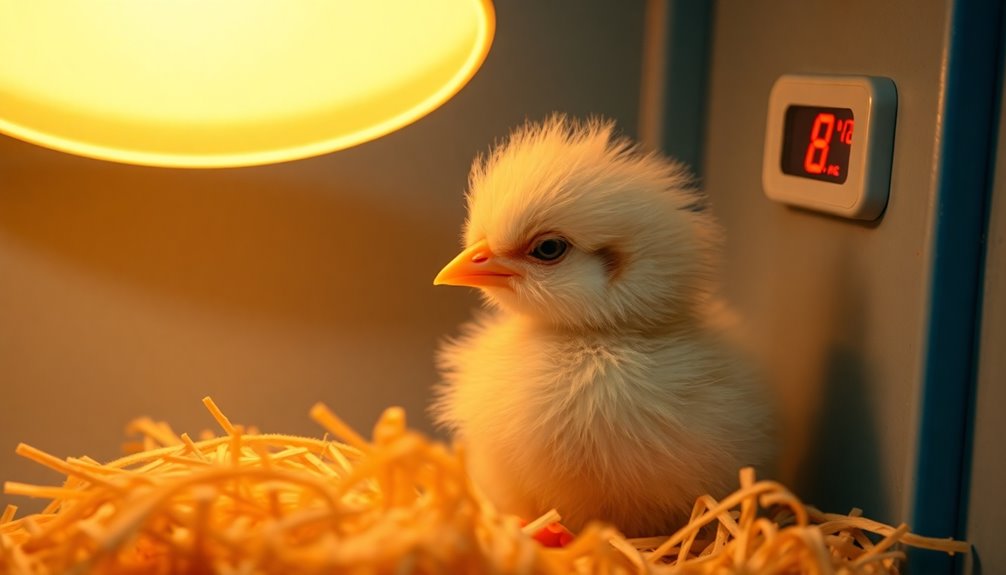
Providing the right heating methods is essential for keeping baby chicks comfortable and healthy. Chicks require an initial brooder temperature of 90°F to 95°F during their first week, gradually decreasing by 5°F each week until reaching room temperature around 70°F.
While heat lamps can provide necessary heat, they pose risks due to high surface temperatures. Instead, consider using radiant heat plates or EcoGlow warmers for safer warmth.
Monitor your chicks' behavior—huddling or spreading wings can indicate their needs. To keep them warm, insulate the brooder with blankets and guarantee adequate ventilation to prevent ammonia buildup.
Regularly check and adjust the heat source based on ambient temperature and chick behavior to maintain their body temperature and prevent cold stress.
Maintaining a Comfortable Brooder
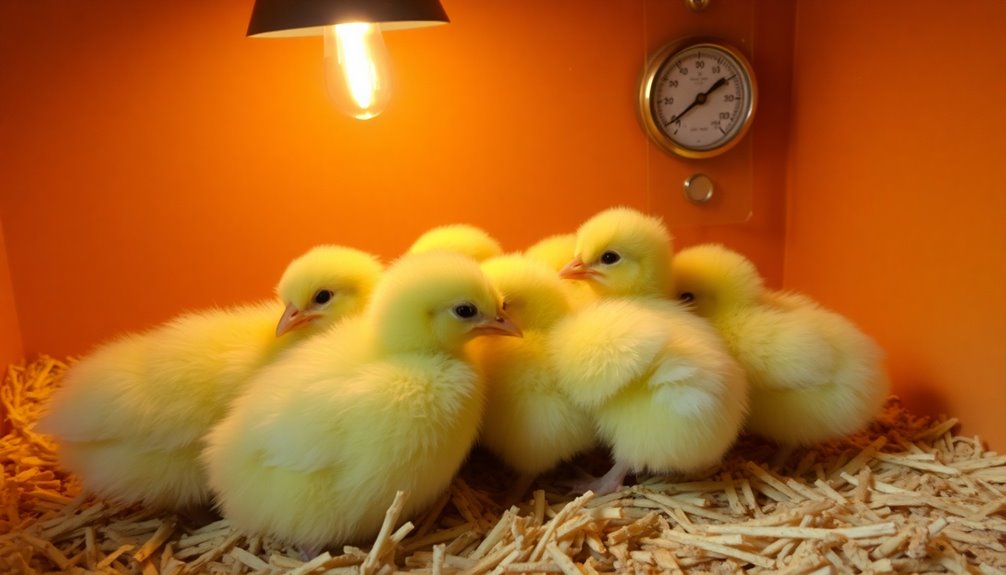
To keep your baby chicks comfortable, you need to maintain the right temperature in their brooder, starting at 90°F to 95°F and gradually lowering it.
Choosing the right bedding and insulation helps create a cozy environment and protects them from drafts.
Regular monitoring of their behavior will guide you in making necessary adjustments to guarantee they stay warm and happy.
Brooder Temperature Control
Maintaining the right temperature in the brooder is essential for your baby chicks' health and comfort.
Start with a brooder temperature of 90°F to 95°F, decreasing by 5°F each week until reaching room temperature around 70°F. Monitoring temperature with a thermometer is important; sudden fluctuations can lead to dehydration, stress, or even death in your chicks.
If you notice them huddling together, it's a sign they're cold and need more heat. Proper ventilation is also critical to prevent overheating and ammonia buildup.
Consider using safe heat sources like radiant heat plates or oil-filled space heaters for consistent warmth, avoiding the fire hazards associated with traditional heat lamps.
Keep your chicks cozy and watch them thrive!
Bedding and Insulation Choices**
Choosing the right bedding and insulation is key to keeping your baby chicks comfortable and healthy in the brooder.
Use soft, absorbent materials like pine shavings or straw for bedding, as they provide excellent insulation while maintaining hygiene. Avoid cedar shavings, which can harm your chicks' respiratory systems.
Make it a habit to regularly remove soiled bedding to prevent ammonia buildup that can irritate their lungs. Additionally, make sure your brooder is properly insulated with draft shields and place it in sheltered areas to minimize cold air exposure.
Finally, keep surfaces dry, as damp bedding can chill your chicks and increase their risk of illness. Prioritizing these factors will create a cozy environment for your little ones.
Nutritional Needs for Warmth
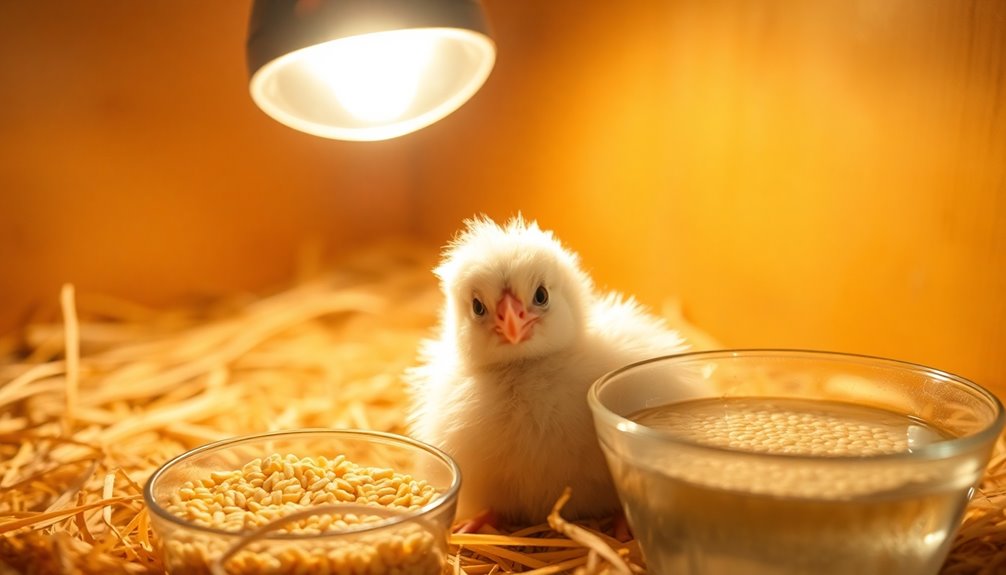
Providing your baby chicks with the right nutrition is essential for keeping them warm and healthy. Start by offering high-quality starter feed with around 20% protein, which supports their rapid growth and energy needs, helping them generate body heat.
Ascertain they've access to fresh, clean food and water for proper hydration, as dehydration can hinder their ability to regulate body temperature effectively.
To boost their warmth, supplement their diet with protein-rich treats like scrambled eggs or mealworms occasionally. A balanced diet not only promotes overall health but also protects against nutritional deficiencies, which can weaken their immune systems and make them more susceptible to cold stress.
Remember to clean the brooder regularly to maintain a healthy environment for your chicks.
Bedding and Ventilation Considerations
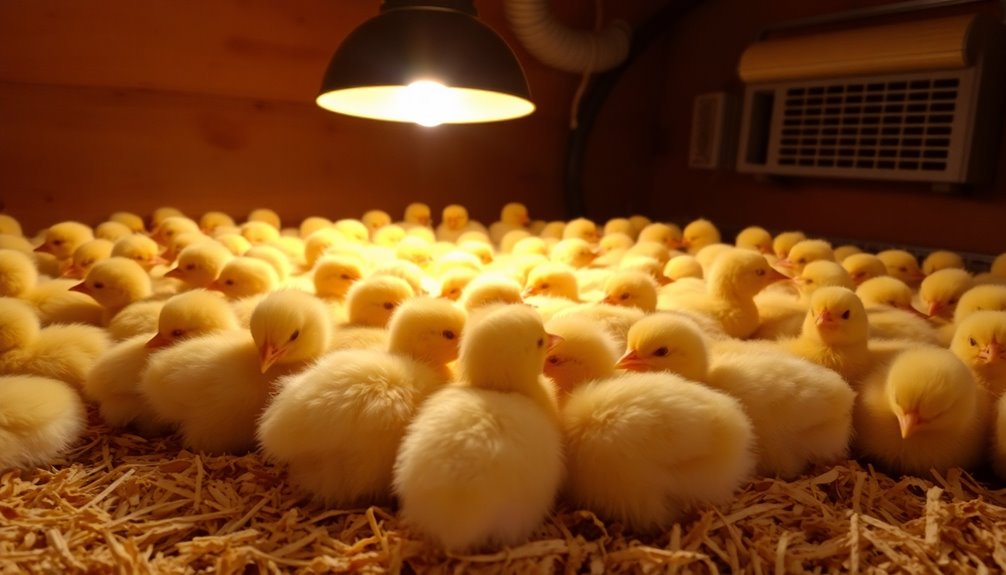
A comfortable brooder environment plays a significant role in keeping your baby chicks warm and healthy. Use soft, absorbent bedding like pine shavings or straw to provide insulation and create a cozy space.
Regularly change soiled bedding to reduce ammonia buildup and maintain hygiene, ensuring the bedding remains dry. Damp conditions can chill your chicks and lead to discomfort.
Adequate ventilation is essential, too; without it, trapped warm air can cause overheating and respiratory issues.
You should aim for a balance—enclosing the brooder can help retain warmth while still allowing fresh air flow.
Behavioral Signs of Discomfort
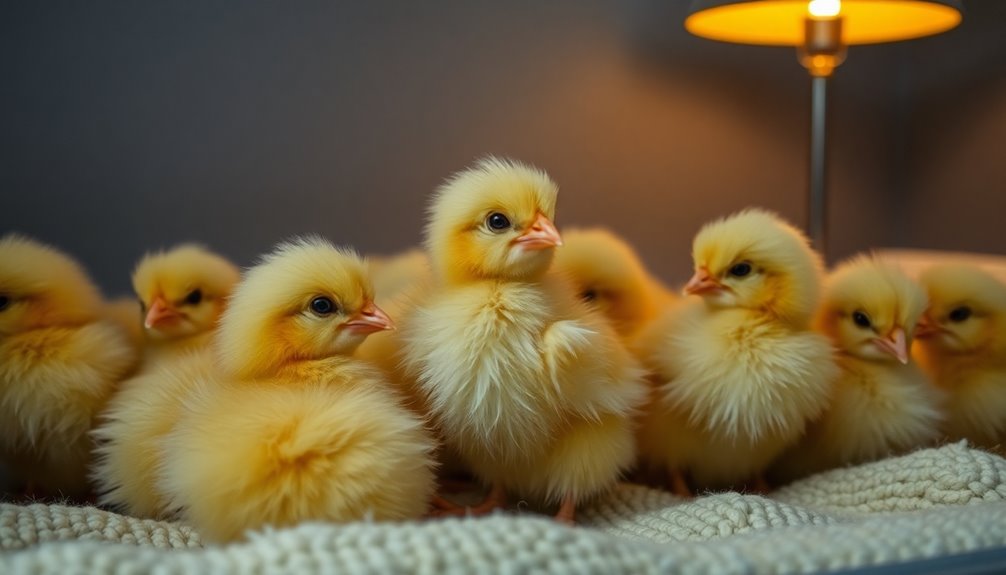
Noticing your baby chicks' behavior can reveal a lot about their comfort level, especially when it comes to temperature.
When chicks are cold, they instinctively huddle together, seeking warmth like they'd from a mother hen.
Look for these signs to guarantee the chicks inside are happy chickens:
- Excessive chirping or peeping can indicate distress from inadequate heat.
- Chicks spreading their wings away from their bodies suggest overheating or temperature fluctuations.
- Restless behavior or digging into bedding shows they need a more secure space.
Frequently Asked Questions
How to Tell if Baby Chicks Are Too Cold?
To tell if your baby chicks are too cold, watch for signs like excessive chirping or peeping, which indicates discomfort.
If they huddle closely together, they're likely seeking warmth. You might also notice them spreading their wings away from their bodies, suggesting they need more heat.
Keep an eye on the brooder temperature; it should remain above 70°F to guarantee your chicks stay comfortable and healthy during their vital early weeks.
How Do You Save a Cold Baby Chick?
If your baby chick's shivering like it just stepped out of an ice bath, you need to act fast!
First, adjust the brooder temperature to 90-95°F, then gradually lower it each week.
Use heat plates or pads for warmth, avoiding heat lamps.
Make certain the brooder's insulated and draft-free.
Keep an eye on your chick—if it huddles or chirps a lot, it's time to provide immediate warmth and some warm water for hydration.
How Long Can Baby Chicks Go Without Heat?
Baby chicks can typically manage without heat for about 2 to 3 hours if the temperature's above 70°F. During this time, they huddle together to stay warm.
However, if they're newly hatched, they need consistent heat for their first week, requiring temperatures of 90°F to 95°F. As they grow, they can tolerate lower temperatures, but keep an eye on them, especially if they're younger than 3 weeks; they can get cold stressed quickly.
How Do You Keep Baby Chicks Warm?
Imagine being a tiny chick in a chilly world—keeping them warm is essential!
Start by setting a brooder temperature of 90-95°F, lowering it by 5°F weekly until it's around 70°F. Use safe heating methods like radiant heat plates, and make certain to provide cozy bedding.
Watch your chicks closely; if they huddle, they're cold.
Finally, keep the brooder draft-free to guarantee they stay snug and healthy in their new environment!
Conclusion
Keeping your baby chicks warm is essential for their health and happiness. If you notice them huddling together or chirping loudly, it's time to take action. Remember, an ounce of prevention is worth a pound of cure! By providing proper heating, cozy bedding, and a well-ventilated brooder, you can guarantee your chicks thrive. With a little care and attention, your feathered friends will grow up strong and lively, ready to take on the world!

